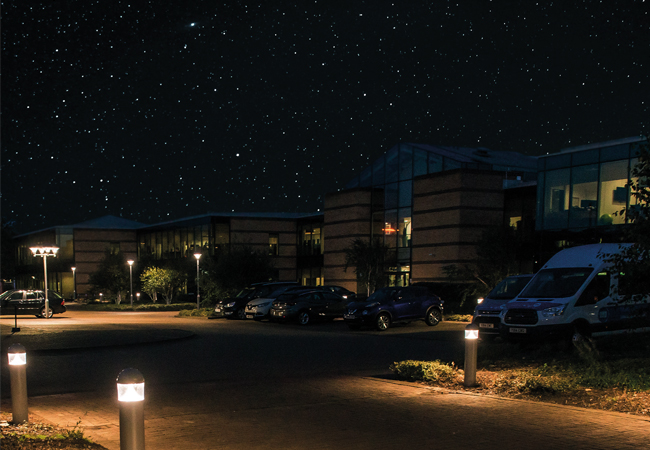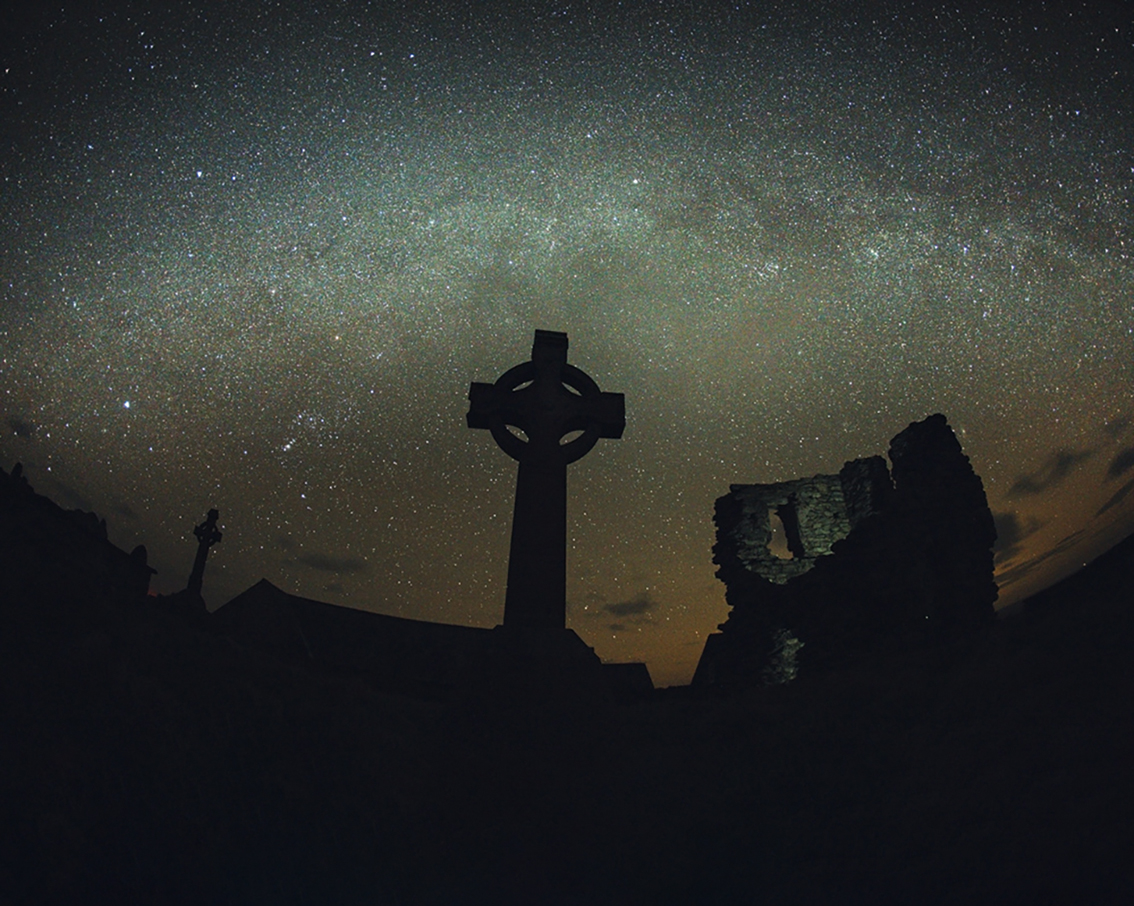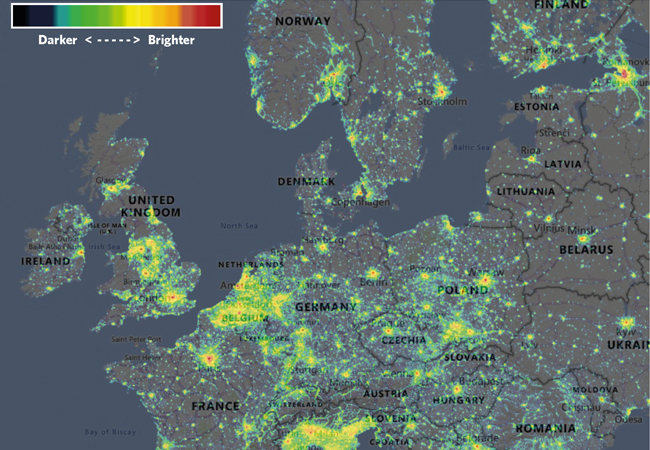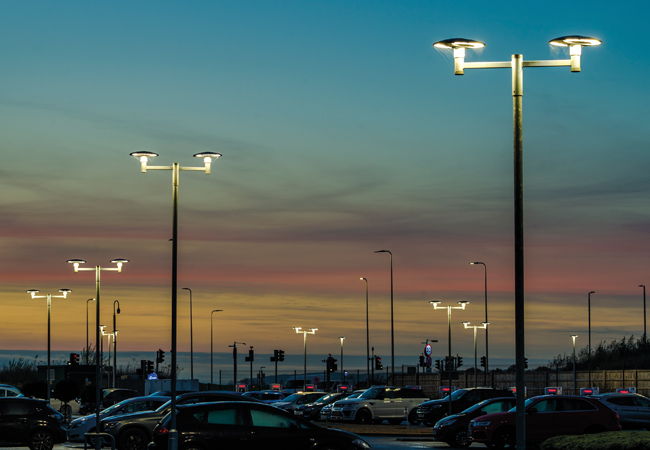
In February 2023, Ynys Enlli (Bardsey Island), two miles off the mainland of north-west Wales, became the first site in Europe to receive International Dark-Sky Association (IDA) Dark Sky Sanctuary certification. This recognises the importance of the exceptional quality of starry nights and a protected nocturnal environment on what is a sparsely populated island (Figure 1). This is not an admonishment of the benefits, and the potential beauty, of artificial lighting, but a celebration of how environments can prosper with careful design and management. This CPD will consider the significant challenges of lighting the more normal, populated environments while respecting the increasing appeal of dark skies

Figure 1: The night sky as viewed from Ynys Enlli (Bardsey Island), located two miles off the tip of the Llýn Peninsula, north Wales, that recently received International Dark Sky Sanctuary certification (Photo credit: Steve Porter/Bardsey Island Trust)
Whereas an IDA Dark Sky Sanctuary designation increases awareness of fragile sites and promotes the long-term conservation of, principally, depopulated areas, the more densely occupied world can present greater challenges. The US-based IDA reports that light pollution is increasing worldwide at twice the rate of global population growth, with 80% of people and more than 99% of the US and European populations living under a light-polluted night sky. As illustrated in Figure 2, a screenshot from www.lightpollutionmap.info, the wider impact of light pollution stretches far beyond city centres.

As discussed at length in CIBSE SLL Lighting Guide 21 (LG21) Protecting the night-time environment,1 pollution from the excessive, uncontrolled, or inappropriate use of artificial light is affecting human health, wildlife behaviour, and the ability to observe stars and other celestial objects. Lighting installations on industrial and commercial sites, outdoor advertising, roadways, and conurbations all need careful consideration to ensure that the design and operation of the numerous and various artificial light sources minimise the creation of adverse conditions.
Human vision during periods of darkness (normally at night) is known as scotopic vision. LG21 notes that the impacts of outdoor lighting at night affecting human perception (which otherwise would be dominated by basic scotopic vision) can be described in terms of three principle factors:
Human scotopic vision
The retina of the eye contains two types of photoreceptors – rods and cones. The rods are the most numerous and are more sensitive than the cones; they are responsible for dark-adapted, or ‘scotopic’, vision – from the ancient Greek skotos, meaning ‘darkness’, and opia, meaning ‘visual condition’. Rods are not used to discriminate colour, although they are most sensitive to wavelengths of light around 498nm (green-blue) and insensitive to wavelengths longer than about 640nm (red).8 The rods are incredibly effi cient photoreceptors, at more than a thousand times as sensitive as the cones. Optimum dark-adapted vision is obtained only after a period of darkness, possibly 30 minutes or longer, because the rod adaption process is much slower than that of the cones.9 The threshold for scotopic vision is around 0.001lux, which is about 1/1,000th of the brightness of a typical full moon.
Sky glow refers to the increase in the brightness of the sky at night that overpowers light produced by natural sources, such as moonlight and the stars. Sky glow results from light that is emitted directly from a fixture, as well as light that is being reflected from the ground, from buildings or other sources. The light traverses the atmosphere, being scattered by air molecules, suspended water droplets and dust particles. Sky glow is diffuse, so it can affect both people and wildlife over great distances. Light that travels near the horizontal is the most difficult to control, as it travels furthest through the lower, denser atmosphere.
Sky glow is most evident over cities and towns, but can also be a blight in less populated areas (as illustrated in Figure 2). In large conurbations, sky glow is evident in all directions, so people living in cities do not experience complete darkness. Circadian entrainment (where physiological or behavioural events match the normal light-dark cycle) is less evident in conurbations compared with rural areas, where there is little or no sky glow.
Light nuisance (often speciously referred to as ‘light trespass’) causes disturbance to individuals and the wider environment, such as when light from a lighting installation enters a nearby residential window or garden (although LG21 points out that some complaints are likely to be because of the activity rather than the lighting itself). The common feature of these complaints is that a significant amount of light crosses a property boundary and impacts on the ability of the adjacent property owner to enjoy, in the legal sense, the use of that property during the evening and into the night.
Glare from lighting is typically divided into one of two categories: disability glare or discomfort glare. Disability glare has an effect on visual capabilities, whereas discomfort glare is more often as a result of being in the presence of bright luminaires. The feature that separates glare from light nuisance is that glare causes discomfort, whereas light nuisance causes disruption. Also, glare can be associated with high-brightness luminaires at a distance far enough away that, while light nuisance is negligible, glare is still evident.
People who are subjected to glare frequently report headaches and fatigue, and it has been found to cause migraines. LG21 reports that this has been shown to impact productivity.
An additional consideration is ‘presence’, where – even if a lighting scheme was designed to avoid sky glow, nuisance and glare – there still exists the possibility of significant impact on dark and sensitive landscapes and wildlife because of the mere presence of the lights. This applies to impacts from both exterior and interior lighting.
It is not just humans who can be affected. All wildlife needs darkness, and light does not need to be obtrusive in the most literal sense to affect both plants and animals. For example, the presence of artificial light was recently reported2 as providing an inconsistent and confusing alternative to the celestial map as a direction-setting compass for dung beetles (and undoubtedly other animals) to reliably and repeatedly guide them to an area where they can store their dung, rest and feed. It has been estimated that artificial light at night may impinge upon two-thirds of the world’s natural habitats.
Work recently reported by Kyba3 suggests that the average night sky got brighter by 9.6% per year from 2011 to 2022, which is equivalent to doubling the sky brightness every eight years. As noted in the recent review paper4 by the IDA, the adoption of solid-state lighting has changed the colour of artificial light emitted into the night-time environment. LG21 reports that the heavily-weighted blue light content of ‘neutral’ and ‘cool’ white LEDs can have a very harmful impact on the night-time environment.
For example, a 4,000K LED source typically has a blue-light content of about 33%, whereas a warmer 2,700K or 3,000K source has 16% or 21% respectively. Blue-rich white light disturbs nocturnal creatures more than warmer monochromatic or narrow-waveband sources, so it is essential to consider the spectral distribution of a source, rather than just its colour temperature. When blue light gets into the sky, the scattering is much greater than that from the warmer end of the spectrum associated with older, traditional light sources.
This may make sky glow more severe even when lighting levels are the same as they would have been with historical lamps, and may extend the impact of city lights much farther into adjacent, ecologically sensitive areas. It also impacts the utility of ground-based astronomical observatories. Existing satellites are not sensitive to blue wavelengths, so they can underestimate the light pollution coming from LEDs.3 However, the IDA review notes research indicating that when LED retrofits are planned carefully, they can hold light pollution steady or even reduce it.
The CIBSE SLL Lighting Handbook (2018) and CIBSE SLL Lighting Guide 6: The exterior environment (2016) give recommended design criteria and guidance for a variety of exterior scenarios. The International Commission on Illumination (CIE) has a classification system5 to help formulate guidelines for assessing the environmental impacts of outdoor lighting, and to provide recommended limits for relevant lighting parameters to contain the obtrusive effects of outdoor lighting within tolerable levels.
The five CIE levels range from 0, intrinsically dark (as in Ynys Enlli) to 5 for high district brightness (as found in town and city centres). However, LG21 notes that the lighting designer must judge the zone carefully, as what may seem like a town centre might be separated from a woodland simply by a road or river – thus, bridges that cross them will effectively fall into two zones.
A significant cause of light pollution is the use of streetlights and other outdoor lighting. A practical measure is to employ properly shielded and directed lighting fixtures that are designed to direct light downward and minimise upward and outward scatter. Energy-efficient lighting fixtures that have low-glare or ‘full cut-off’ designs (such as those shown in Figure 3) minimise the amount of light that is wasted and reduce the amount of glare that is produced. This not only helps to protect dark skies, but can also save energy and potentially reduce life-cycle costs.

Lighting fixtures that are designed to be dimmed or turned off when they are not needed can provide significant benefit. For example, outdoor lights can be set to turn off or dim automatically during certain hours of the night. However, care is needed to ensure switching frequency is not so high as to increase annoyance.
IDA’s Fixture Seal of Approval programme certifies independently tested outdoor lighting fixed-mounting luminaires as being dark-sky friendly. This sets requirements such as: upward light output ratio (ULOR) of less than the lower of 0.5% light output or 50 lumens; a dimming capability to 10% of full rating; and a maximum correlated colour temperature (CCT) of 3,000K.
Practically, this can provide opportunity for narrow spectrum amber LEDs with CCT £2,500K where illumination for safety or security is not the primary concern and good colour rendering is unimportant. These also have the appearance of legacy low-pressure sodium lamps (which have a characteristic wavelength of 589nm), but with better colour rendering, by having a wider band of output wavelengths, centred around 590nm.
However, higher-temperature LEDs that are still less than 3,500K CCT (warm white) – potentially used at lower lighting levels – are likely to be more appropriate where colour rendering is important to the acceptable use of the space, such as for historic and cultural applications, and for areas that are designed for regular, high use night-time pedestrian traffic, and spaces where activities such as maintenance take place.
The approaches outlined above may not be sufficient, as any new light, even if shielded, will add pollution to the night environment after being reflected off the surfaces being lit. New metrics are being investigated that may better interpret the holistic polluting impact of artificial light, such as those discussed in the recent work by Falchi and Bara6 suggesting new approaches that treat light as a true pollutant, which could include defining a suitable set of sky-quality indicators and agreeing their acceptable limits.
LG21 highlights that, in the UK, light is recognised as a potential statutory nuisance in the Clean Neighbourhoods and Environment Act 2005 – although some facilities are exempt, including roads, airports, military facilities, transport hubs, goods vehicle operating centres, lighthouses, and prisons.
Regional authorities, councils and parishes in a dark-skies area can set local planning requirements for evidencing that proposed lighting of new developments is limited to that required for specific needs of access, utility, safety and security, and that it is appropriately designed, controlled and – importantly – includes a workable, measurable maintenance plan.
As noted by the UK’s All-Party Parliamentary Group for Dark Skies,7 new legislation is likely to be necessary to truly protect the UK’s dark skies and night-time landscape. It recommends: strengthening the National Planning Policy Framework to make extensive specific reference to the control of obtrusive light; expanding the scope of the planning permission process by introducing regulations for exterior lighting that are similar to those that currently cover advertisements; and strengthening the Statutory Nuisance Provisions, removing exemptions to give local authorities a more effective method of preventing nuisance lighting.
With a holistic approach to planning, installation and operation – combining lighting solutions that are properly and thoughtfully matched for the local environment with an increasingly available range of reputable dark-sky luminaires, fittings and controls – there is great opportunity for a truly dark future.
Further reading:
CIBSE SLL LG21 provides a great reference for this area and is free for CIBSE members.
Institution of Lighting Professionals Guidance Note 01/20 Guidance notes for the reduction of obtrusive light provides some excellent succinct information and is freely downloadable.
References:
- Peck, L, Lighting Guide 21: Protecting the night-time environment, CIBSE SLL 2021.
- bit.ly/CJApr23CPD1 – accessed 24 February 2023.
- Kyba, C et al, Citizen scientists report global rapid reductions in the visibility of stars from 2011 to 2022, Science, 19 January 2023 DOI: 10.1126/science.abq7781.
- Artificial Light at Night: State of the Science 2022, International Dark-Sky Association, DOI: 10.5281/zenodo.6903500.
- CIE 150:2017 Guide on the Limitation of the Effects of Obtrusive Light from Outdoor Lighting Installations 2nd Edition, CIE 2017.
- bit.ly/CJM
- Falchi, F, Bará, S, A linear systems approach to protect the night sky: implications
for current and future regulations, Royal Society Open Science 2020. Skies, 2021 –
bit.ly/CJApr23CPD2. - bit.ly/CJApr23CPD3 – accessed 24 February 2023.
- bit.ly/CJApr23CPD4 – accessed 24 February 2023.

